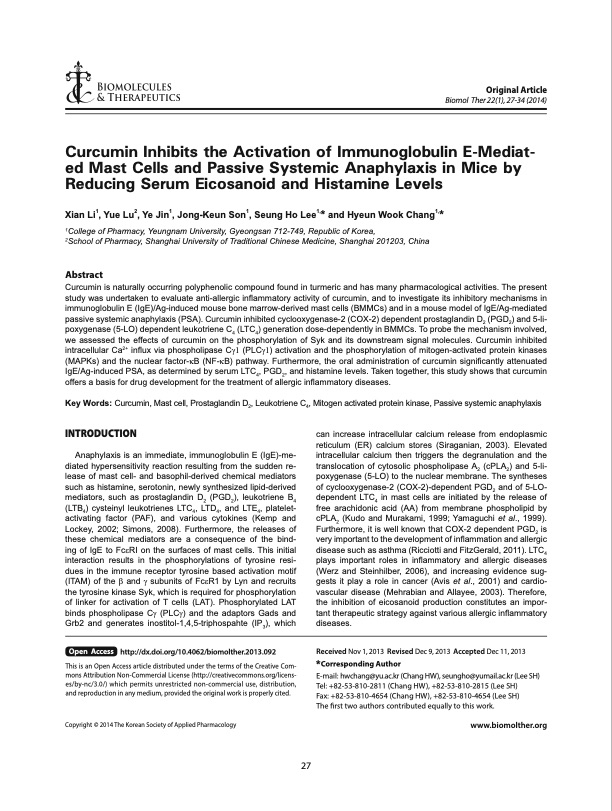PDF Publication Title:
Text from PDF Page: 001
Original Article Biomol Ther 22(1), 27-34 (2014) Curcumin Inhibits the Activation of Immunoglobulin E-Mediat- ed Mast Cells and Passive Systemic Anaphylaxis in Mice by Reducing Serum Eicosanoid and Histamine Levels Xian Li1, Yue Lu2, Ye Jin1, Jong-Keun Son1, Seung Ho Lee1,* and Hyeun Wook Chang1,* 1College of Pharmacy, Yeungnam University, Gyeongsan 712-749, Republic of Korea, 2School of Pharmacy, Shanghai University of Traditional Chinese Medicine, Shanghai 201203, China Abstract Curcumin is naturally occurring polyphenolic compound found in turmeric and has many pharmacological activities. The present study was undertaken to evaluate anti-allergic inflammatory activity of curcumin, and to investigate its inhibitory mechanisms in immunoglobulin E (IgE)/Ag-induced mouse bone marrow-derived mast cells (BMMCs) and in a mouse model of IgE/Ag-mediated passive systemic anaphylaxis (PSA). Curcumin inhibited cyclooxygenase-2 (COX-2) dependent prostaglandin D2 (PGD2) and 5-li- poxygenase (5-LO) dependent leukotriene C4 (LTC4) generation dose-dependently in BMMCs. To probe the mechanism involved, we assessed the effects of curcumin on the phosphorylation of Syk and its downstream signal molecules. Curcumin inhibited intracellular Ca2+ influx via phospholipase Cγ1 (PLCγ1) activation and the phosphorylation of mitogen-activated protein kinases (MAPKs) and the nuclear factor-κB (NF-κB) pathway. Furthermore, the oral administration of curcumin significantly attenuated IgE/Ag-induced PSA, as determined by serum LTC4, PGD2, and histamine levels. Taken together, this study shows that curcumin offers a basis for drug development for the treatment of allergic inflammatory diseases. Key Words: Curcumin, Mast cell, Prostaglandin D2, Leukotriene C4, Mitogen activated protein kinase, Passive systemic anaphylaxis INTRODUCTION Anaphylaxis is an immediate, immunoglobulin E (IgE)-me- diated hypersensitivity reaction resulting from the sudden re- lease of mast cell- and basophil-derived chemical mediators such as histamine, serotonin, newly synthesized lipid-derived mediators, such as prostaglandin D2 (PGD2), leukotriene B4 (LTB4) cysteinyl leukotrienes LTC4, LTD4, and LTE4, platelet- activating factor (PAF), and various cytokines (Kemp and Lockey, 2002; Simons, 2008). Furthermore, the releases of these chemical mediators are a consequence of the bind- ing of IgE to FcεRI on the surfaces of mast cells. This initial interaction results in the phosphorylations of tyrosine resi- dues in the immune receptor tyrosine based activation motif (ITAM) of the b and γ subunits of FcεR1 by Lyn and recruits the tyrosine kinase Syk, which is required for phosphorylation of linker for activation of T cells (LAT). Phosphorylated LAT binds phospholipase Cγ (PLCγ) and the adaptors Gads and Grb2 and generates inostitol-1,4,5-triphospahte (IP3), which Open Access http://dx.doi.org/10.4062/biomolther.2013.092 This is an Open Access article distributed under the terms of the Creative Com- mons Attribution Non-Commercial License (http://creativecommons.org/licens- es/by-nc/3.0/) which permits unrestricted non-commercial use, distribution, and reproduction in any medium, provided the original work is properly cited. Copyright © 2014 The Korean Society of Applied Pharmacology can increase intracellular calcium release from endoplasmic reticulum (ER) calcium stores (Siraganian, 2003). Elevated intracellular calcium then triggers the degranulation and the translocation of cytosolic phospholipase A2 (cPLA2) and 5-li- poxygenase (5-LO) to the nuclear membrane. The syntheses of cyclooxygenase-2 (COX-2)-dependent PGD2 and of 5-LO- dependent LTC4 in mast cells are initiated by the release of free arachidonic acid (AA) from membrane phospholipid by cPLA2 (Kudo and Murakami, 1999; Yamaguchi et al., 1999). Furthermore, it is well known that COX-2 dependent PGD2 is very important to the development of inflammation and allergic disease such as asthma (Ricciotti and FitzGerald, 2011). LTC4 plays important roles in inflammatory and allergic diseases (Werz and Steinhilber, 2006), and increasing evidence sug- gests it play a role in cancer (Avis et al., 2001) and cardio- vascular disease (Mehrabian and Allayee, 2003). Therefore, the inhibition of eicosanoid production constitutes an impor- tant therapeutic strategy against various allergic inflammatory diseases. Received Nov 1, 2013 Revised Dec 9, 2013 Accepted Dec 11, 2013 *Corresponding Author E-mail: hwchang@yu.ac.kr (Chang HW), seungho@yumail.ac.kr (Lee SH) Tel: +82-53-810-2811 (Chang HW), +82-53-810-2815 (Lee SH) Fax: +82-53-810-4654 (Chang HW), +82-53-810-4654 (Lee SH) The first two authors contributed equally to this work. www.biomolther.org 27PDF Image | Curcumin Inhibits the Activation of Immunoglobulin

PDF Search Title:
Curcumin Inhibits the Activation of ImmunoglobulinOriginal File Name Searched:
curcumin-mast-cells.pdfDIY PDF Search: Google It | Yahoo | Bing
Salgenx Redox Flow Battery Technology: Salt water flow battery technology with low cost and great energy density that can be used for power storage and thermal storage. Let us de-risk your production using our license. Our aqueous flow battery is less cost than Tesla Megapack and available faster. Redox flow battery. No membrane needed like with Vanadium, or Bromine. Salgenx flow battery
CONTACT TEL: 608-238-6001 Email: greg@salgenx.com (Standard Web Page)